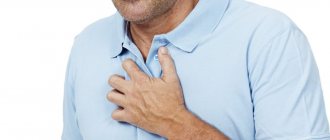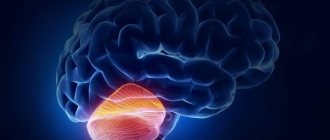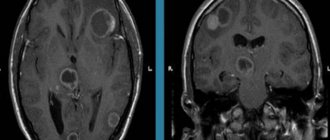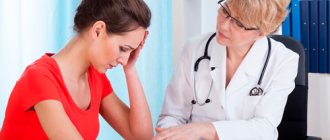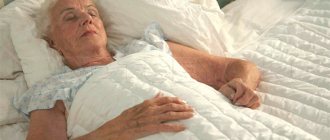There is no consensus on what neuroses are. The dominant point of view in medicine today is based on the causes (etiology) that cause neurosis. This point of view on diseases of psychogenic etiology is appropriate and has practical importance when choosing a strategy for the treatment of neuroses and their prevention.
Neuroses should be understood as “...functional disorders of nervous activity caused by mental trauma, in other words, by stimuli, the effect of which is determined not by their physical parameters, but by their informational value.” Information that becomes the cause of the development of neuroses can be transmitted orally or in writing, and can also be of a “visual” nature (for example, a person’s participation or third-party observation of any traumatic events that cause internal conflict).
The most common causes of the development of neuroses include:
- love failures;
- family conflicts;
- loss (death) of loved ones;
- troubles at work, dismissal;
- bringing to punishment for a crime;
- threat to life, health, well-being;
- collapse of long-term plans.
However, it is information transmitted through speech that is the most common cause of the development of neuroses. Such information can have a one-time, but powerful blow to the human psyche, or deliver mild traumatic experiences over a long distance, contributing to the accumulation of internal tension, with the increasing manifestation of symptoms and signs of neuroses.
General symptoms and signs of neuroses
Based on the variety of life situations that cause internal conflict, the symptoms and signs of neuroses are often quite complex to identify variations in unusual reactions and behavior. In other words, very often a person does not correlate such reactions and behavior with the presence of a neurotic disease, considering them to be personality traits.
Neuroses can cause the emergence and development of somatic pathology. This is caused by a reaction to a stress factor, which provokes various disorders of the autonomic nervous system, which is responsible for the functioning of internal organs, glands, blood and lymphatic vessels.
As a rule, the personality of a neurotic combines variations of common characteristics characteristic of most cases:
- dependence on the assessment of others;
- illogical aggressiveness;
- hostile ambition;
- sexual compensation for low self-esteem;
- expression of pathologically inflated self-esteem;
- workaholism or, on the contrary, an infantile attitude to work;
- suppression of feelings of inferiority.
It is important to understand that the above symptoms and signs of neuroses reveal themselves in the dynamics of life. For example, in contrast to a non-neurotic personality, a person with neurosis will justify his illogical behavior, find reasons for fears, helplessness and passivity when it is necessary to make decisions, as in the case of aggression, hatred, and socially unacceptable actions on his part.
Rice. 1. Types and causes of neuroses.
Symptoms of neuroses in children and adolescents
According to some authors, mainly from a psychoanalytic direction, the prerequisites for the development of neuroses are unresolved internal conflicts in childhood and adolescence. As a rule, symptoms of neuroses in children and adolescents can manifest themselves against the background of difficult situations for a fragile psyche, addictive behavior of parents, which create the basis for the development of a full-fledged neurotic disorder, for example:
- strict upbringing, often with violence;
- family conflicts, divorce, alcoholism of one or both parents;
- development of feelings of insecurity, inferiority, helplessness.
At the same time, the symptoms of neuroses in children and adolescents can have either a pronounced character for others or be hidden behind an outwardly calm (depressed) state, masked as the “indifferent” character of the child. Such symptoms of neuroses include excessive tearfulness, touchiness, hysterical reactions, and manifestations of excessive and inappropriate aggression. Signs of neuroses that are more difficult to recognize as a psychopathological state are apathy, isolation, increased fatigue, and sleep disturbances.
Rice. 2. Neuroses and other diseases.
Symptoms and signs of neuroses in men
It is generally accepted that neurotic diseases are characteristic of women. In practice, neuroses occur equally in both women and men. The same can be said about the symptoms of neuroses, which are associated in the public consciousness with “unbalanced” reactions of women to stress - they are not alien to men.
The characteristic symptoms and signs of neuroses in men include the following:
- apathy;
- lack of initiative;
- fatigue;
- decreased speed of thinking;
- forgetfulness;
- inadequate (“violent”) reactions to situations;
- mood swings.
Due to the peculiarities of male upbringing, among the symptoms and signs of neuroses in men, in rare cases, there may be uncontrollable tearfulness, a tendency to public self-accusation or other attacks of a hysterical nature. In other cases, men simply find the strength to overcome the signs of “female” type neuroses or do not demonstrate them in front of other people.
Rice. 3. Neuroses among mental disorders.
Symptoms and signs of neuroses in women
Symptoms and signs of neuroses in women differ from those of the opposite sex due to the physiological characteristics of the body and the characteristics of upbringing. If in men, for example, reversible impotence is often encountered, then in women, amenorrhea is a symptom of neuroses similar in type to the “nature of sex”.
Among the symptoms and signs of neuroses in women, the most striking are:
- anxiety;
- irritability;
- expressiveness of behavior;
- refusal to eat;
- excessive tearfulness;
- mood swings.
More often in women than in male patients, among the symptoms of neuroses are complaints of insomnia, dreams of a frightening nature (up to the appearance of sleep paralysis) or difficulties in falling asleep. However, in each specific case, the complex of symptoms of neuroses will depend on the case and individual characteristics of the individual.
The problem of inflammatory diseases of the paranasal sinuses (SNS) remains relevant today and has important social significance. In the structure of inflammatory diseases of the upper respiratory tract, rhinosinusitis (RS) plays a leading role [1, 2]. On average, 5-15% of adults and 5% of children suffer from some form of acute bacterial sinusitis [3, 4]. According to various epidemiological studies conducted in more than 30 countries, the incidence of MS over the past decades has increased almost 3 times, and the proportion of hospitalized patients increases annually by an average of 1.5-2% [5-7], amounting to 40-50%. all patients in ENT hospitals [8—10]. In recent years, acute MS is diagnosed annually in 10 million Russians [11]. The increase in the prevalence of inflammatory diseases of the acute respiratory tract is largely due to serious environmental problems, in particular due to significantly increased air pollution, an increase in the number of respiratory viral infections, the number of inhaled allergens, a decrease in the reserve capacity of the mucous membrane of the upper respiratory tract, and increasingly growing resistance microflora [12]. Similar trends are typical for other countries. In Canada, the prevalence of MS reaches 135 per 1000 population [13]. According to the US National Center for Disease Statistics, sinusitis has become the most common chronic disease in this country, affecting 14.7% of Americans, surpassing arthritis and hypertension in frequency of detection. Therefore, the treatment of sinusitis is now one of the main problems of otorhinolaryngology, requiring increasingly significant financial costs. Along with the economic component of the problem, there is also its social side. MS significantly reduces people's quality of life. Patients with MS have worse indicators of pain sensitivity and social activity than patients with coronary insufficiency and chronic obstructive pulmonary diseases [8, 14]. Similar results were obtained in Russia [6, 15]. MS play an active role in the formation of numerous complications. First of all, we are talking about rhinogenic orbital and intracranial complications, the frequency of which does not show a noticeable tendency to decrease and ranges from 6.6 to 12.4% [16, 17].
In the works of H. Stammberger [18, 19] on the study of the physiology and pathophysiology of the nasal cavity and SNP, it was proven that the ostiomeatal complex plays a significant role in the development of inflammatory processes in them. Some congenital diseases (cystic fibrosis, Kartagener's syndrome), dysfunction of the immune system (allergic rhinosinusitis, nosocomial sinusitis), as well as characteristics of virulent microflora can lead to the development of recurrent sinusitis.
The state of the autonomic nervous system (ANS) undoubtedly plays a significant role in the occurrence and development of the pathology of SNP. The ANS is a section of the nervous system that regulates the activity of internal organs, endocrine and exocrine glands, blood and lymphatic vessels, plays a leading role in maintaining the constancy of the internal environment of the body and in adaptive reactions. Anatomically and functionally, the ANS is divided into central (limbic-reticular complex), segmental-peripheral (sympathetic and parasympathetic divisions) and intraorgan, i.e., autonomous (or metasympathetic) divisions [20]. The sympathetic nervous system enhances metabolism, increases the excitability of most tissues, and mobilizes the body's forces for vigorous activity. The parasympathetic system helps restore spent energy reserves and regulates the functioning of the body during sleep. Under the control of the autonomous system are the organs of circulation, respiration, digestion, excretion, reproduction, etc., as well as metabolism and growth. In fact, the efferent section of the ANS carries out nervous regulation of the functions of all organs and tissues, including the musculoskeletal system (bones, muscles, ligaments, etc.) [21, 22].
When assessing the state of the ANS, one should adhere to the functional-dynamic principle: study of autonomic tone (VT), autonomic reactivity (VR), autonomic support of activity (VOS). VT and VR give an idea of the homeostatic capabilities of the body, WOD - about adaptive mechanisms. Regulatory apparatuses that maintain metabolic balance and the relationship between the sympathetic and parasympathetic systems are actively involved in ensuring tone. Methods for studying the ANS: special questionnaires, tables recording objective vegetative indicators and their combinations. Autonomic reactions that occur in response to external and internal stimuli characterize V.R. Methods for studying VR: pharmacological, physical. VOD indicators make it possible to judge the adequate support for the functioning of organs and systems of the body and behavior. The study of VOD is carried out using experimental modeling of activity: emotional, orthoclinostatic test, mental calculation [21, 22].
To date, based on many years of morphological studies of the nasal mucosa, it is known that an exceptional feature in the structure of its vascular bed, not found in any other parts of the mucous membrane of the respiratory tract, is a system of cavernous venous plexuses located in the lamina propria between the capillary network and venules, and have important functional and clinical significance [23-25].
Many authors have identified the important role of the ANS in the development of diseases of the ENT organs and the need for correction of autonomic disorders during their treatment. The study of the effect of VNS on the ENT organs has a history of more than 20 years. In particular, in patients with allergic rhinitis (AR) [15, 26, 27], dysfunction of suprasegmental autonomic structures and the parasympathetic direction of the autonomic response are detected. Similar results were obtained by T.R. Batyrshin [28, 29], who came to the conclusion that patients with vasomotor rhinitis are characterized by a state of autonomic imbalance, and successfully used a 15% dimephosphone solution in the conservative treatment of vasomotor rhinitis. There is information in the literature that dimephosphone has vegetotropic and corrective vascular reactivity effects in the head region [30, 31].
According to V.B. Trushin [32], all patients with nosebleeds were found to have disturbances in the autonomic regulation of the functions of the cardiovascular system (CVS) in the form of rapid depletion of sympathetic mechanisms for ensuring orthostasis, causing relapses of nosebleeds. Analysis of changes in autonomic parameters during an orthostatic test allows us to sufficiently predict the occurrence of relapses of nosebleeds. The highest risk of recurrent bleeding is in patients with insufficient sympathetic support for the orthostatic test. Patients with excess blood pressure have a lower risk and patients with an adequate type of sample organization have the lowest risk.
N.N. Naumenko [5], based on a study of rhinobronchial and rhinocardial relations in patients with chronic polypous rhinosinusitis (PRS), vasomotor rhinitis and signs of a pre-asthmatic state using indicators of bronchial resistance and cardiointervalography (CIG), came to the conclusion that violations of the adaptive-trophic function of the ANS in patients with pathology of the upper respiratory tract lead to the development of a generalized neurodystrophic process and pathological adaptation reactions in the respiratory, cardiovascular and immune systems.
Studying the factors of development of exudative otitis media (EO) in children, G.D. Tarasova [33] came to the conclusion that local hemodynamic and secretory changes in the mucous membrane are a consequence of disturbances in autonomic innervation. Due to the fairly frequently detected neurological pathology in patients with ESO, it is recommended to conduct a neurological examination, including a study of the vegetative status, and prescribe appropriate therapy.
CM. Puhlik et al. [34], studying the state of the ANS in patients with AR, revealed dysfunction of suprasegmental autonomic structures in a significant number of cases. The majority of patients with AR showed a decrease in BP and VOD.
A.A. Abdurakhmanova et al. [35], tracing general patterns in the violation of autonomic regulation associated with hyperreactivity of adaptation processes in patients with vasomotor rhinitis, noted the predominance of hypersympathicotonic reactivity. According to the CIG, changes in central and peripheral hemodynamics in children and adolescents with various types of autonomic dystonia are unidirectional and depend to a greater extent not on the form of rhinitis, but on the type of ANS regulation. At the same time, the chronic inflammatory process of the nasal cavity causes vegetatively caused functional changes in the cardiovascular system, determined by both clinical and functional examination methods, which can be interpreted as rhinocardial syndrome.
A.Yu. Yurkov et al. [36], studying the pathology of benign tumors and tumor-like hyperplastic-dystrophic processes in the larynx, revealed disturbances in the adaptive-trophic function of the ANS, and in patients with functional dysphonia - disturbances in the activity of the efferent link in the regulation of the trophic state and the functional activity of executive tissues and organs.
According to Yu.S. Magomedova, N.A. Gitinov [37], during an exacerbation of bronchial asthma (BA), an imbalance of the ANS occurs with a pronounced predominance of the sympathetic department. The participation of the ANS in regulation is not limited to its influence on the circulatory system, but also affects other organs and systems, primarily the respiratory system.
I.A. Tikhomirova [38] revealed that the most common cardiac syndrome correlating with the pathology of the ENT organs is cardiac dysrhythmia (tachycardia, bradycardia, arrhythmia). To identify it, the methods of choice are 24-hour Holter monitoring and assessment of the wave structure of the heart rhythm.
M.V. Batrak et al. [39] conducted a study of heart rate variability (HRV) in patients with a combination of deviated nasal septum and vasomotor rhinitis before and after surgical treatment. It has been established that heart rate is the most sensitive indicator of the body's adaptive activity. The results obtained allow us to suggest the regulatory impact of VNS on the course of the postoperative period in patients after rhinosurgery and the possibility of using HRV indicators to predict its course.
M.B. Samotokin et al. [40] found that a large number of autonomic nervous structures are located in the primary and secondary lymphoid organs, as well as in the mucosa associated with lymphoid tissue. The assessment of neurovegetative status was based on a functional-dynamic study of the ANS. In children with impaired neurovegetative status, hyperplasia of the pharyngeal tonsil is a sign of pathological adaptation.
I.V. Stagnieva [41], studying the cause of pain in MS using the Kerdo autonomic index, found that the presence of disorders of the ANS functioning affects the pathogenesis of the disease, determining its clinical manifestations in the form of the intensity of the pain symptom.
In our works [42, 43], devoted to the study of the types of vegetative response - autonomic constitution (VC) in a population of healthy young people, it was found that in 92% of observations a dystonic type of VC was identified, of which 51% were vagotonic and 41% sympathicotonic, and 8% of those examined had normotonic (or eutonic) type V.K. Purely sympathicotonic and vagotonic types of VK were not found among those examined. In the pedigrees of individuals with vagotonic and dystonic types of VK, in 62.9% of cases, diseases of the ENT organs, lower respiratory tract (rhinosinusitis, tonsillitis, otitis media, bronchitis, asthma, pneumonia) and diseases of the gastrointestinal tract (gastritis, gastric ulcer, cholecystitis, colitis) ( p
<0.05).
Diseases of the cardiovascular system (hypertension, stroke, myocardial infarction) were mostly (61.4%) recorded in the group of people with sympathicotonic and dystonic types of CV ( p
<0.05).
Within the framework of psychosomatic disorders, conditions that are closely related to disorders of autonomic regulation are considered. The consequence of these disorders is the formation of viscerosomatic (sympatho- and vago-dependent) diseases in organs and systems [21, 44, 45].
A number of authors [39, 46] report significant disturbances of the ANS in inflammatory diseases of the nose, pharynx, ear, larynx and the development of chronic forms of ENT pathology. The authors note the predominance of the parasympathetic direction in the autonomic response. In particular, with vasomotor rhinitis, general patterns are observed in the disturbance of autonomic regulation with a predominance of hypersympathicotonic reactivity and the identification of characteristic changes in the epithelium and stroma of the nasal mucosa [47].
Thus, the presented literature data indicate the participation of the ANS in the occurrence and development of many pathological conditions of the ENT organs, the lack of uniform methodological approaches in the study of the ANS and the assessment of clinical manifestations of autonomic dysfunction syndromes. Further study of this problem is necessary, taking into account the types of autonomic constitution in patients with diseases of the upper respiratory tract.
Symptoms of obsessive neurosis (OCD)
Symptoms of obsessive neurosis (F42 according to ICD-10) include obsessive thoughts and actions of a stereotypical nature. In almost all cases, there is anxiety, which is directly related to the fear of unlikely negative (dangerous) consequences. For example, some of these symptoms include:
- checking the gas stove;
- lighting check;
- checking doors (apartment, garage, car);
- checking the order in the apartment;
- frequent cleaning of the apartment;
- frequent hand washing, showering;
- excessive attachment to people, things;
- adherence to unusual rituals;
- tendency to count something.
Treatment of autonomic neuroses
Treatment includes the elimination of traumatic factors and symptomatic therapy. Psychotherapy is especially effective for autonomic neuroses of the first group. Physiotherapy and drug therapy (meprotane, bromides, pentamine, hexomethosine, pachycarpine) are also used. For neuroses of the third group, in some cases surgical interventions are performed (preganglionic sympathectomy). The neuroses of the second group are most resistant to treatment. Prevention of autonomic neuroses consists of proper organization of work and rest, sufficient but not excessive physical activity, hardening and other general strengthening measures.
Symptoms of hysterical neurosis
Symptoms of hysterical neurosis (F44 according to ICD-10) include behavioral characteristics and reactions of a somatic nature. In addition to emotional imbalance, a strong reaction (positive, negative) even to minor events in life, the following signs that arise against the background of a pathological condition should be noted:
- convulsions, tremors;
- problems with coordination of movements;
- loss of speech abilities;
- stuttering;
- loss of sensation;
- hearing loss;
- loss of vision;
- loss of facial expressions;
- paralysis;
- vegetative disorders.
Symptoms of anxiety neurosis
Anxiety neurosis can manifest itself in various symptom complexes, depending on the specific case. Among such somatic and physiological manifestations associated with disruption of the autonomic nervous system, as well as mental symptoms of anxiety neurosis, the following are often noted:
- anxiety;
- fear;
- agitation;
- depression;
- obsessive thoughts;
- sleep disorders;
- headache;
- heartbeat disturbances;
- changes in blood pressure;
- breathing problems;
- gastrointestinal disorders.
